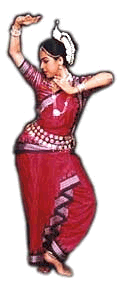 |
|
Odissi,
originated in Orissa is perhaps the most lyrical Indian
classical dance form. The postures of Odissi reflect
specific moods. The movements are swaying and graceful.
It is the dance of love, delight, and intense passion,
lyrical, pure, divine and human, all rolled into one. The
performance and enjoyment of Odissi dance recital, so
tender and vigorous and devotional, moving in
sculpturesque poses, is an unique experience; a constant
source of delight & inspiration. It transcends all
the limits of communication leading to a rich aesthetic
& spirtual experience. A brief
background of this form
Traditionally
the classical dance form of Odissi was performed as
mahari or devadasi dance, in front of and dedicated to
Lord Jaganath in the temples in the state of Orissa,
particular in the temple of Lord Jaganath in Puri and the
famous Konark Sun Temple. Having been revived from
virtual obscurity, it is possible that Odissi is an even
earlier dance form than Bharata Natyam, another better
known south Indian temple dance form (on which there will
be a feature in a later edition of The Muse), with
sculptural forms of Odissi dating to 2nd century B.C.
With
social and political change in Indian society and later
the suppression of the 'mahari' or 'devadasi' tradition
by the British authorities, this classical dance form
moved out of the temples and took up a place in the wider
Indian society, being performed by individual dancers,
travelling and local dance troupes. This process began in
the 16th century with young dancers called 'Gotipuas',
performing the dance outside on the temples.
Much of
Odissi was revived while India fought for her
independence through the early years of this century and
after Independence in 1949. It was necessary indeed for
some of the regeneration of the dance to arise from
research on the sculptures of the temples in Orissa
because a very significant part of the dance had been
lost. It was revived by a number of individuals, who
crystallised the repertoire and trained new performers
and teachers; people such as Pankaja Charan Das, Kelu
Charan Mahapatra, Mohadev Rout, Deba Prasad Das and Hare
Krishna Behera. The great teachers of the classical dance
forms are known as gurus and are treated with great
respect by their pupils, the relationship being more like
that one has with a priest.
The
classical dance form of Odissi is a dance form made up of
its own vocabulary of foot positions, head movements, eye
movements, body positions, hand gestures, rhythmic foot
work, jumps, turns and spins. The dance form is then in
turn made up of traditional dance pieces which have been
handed down from teacher to pupil. Some of these pieces
have been formulated in the distant past when it was used
in temple worship, others arise from the great Indian
spiritual writings, such as poetry and epic stories, and
finally there are modern pieces which have been the
inspired work of the gurus and choreographed by them.
The key
noticeable difference between the two forms, Odissi and
Bharata Natyam, is that Odissi has more curves, curves of
the body which can make it a more sensual dance form, as
opposed to the athleticism and angular nature of Bharata
Natyam. Poses, as one might find in Indian sculpture, are
at the core of Odissi. The most beautiful of these is the
'tribunga' position, with three bends in the body, at the
neck, waist and knee. If you go to any collection of
Indian art, you will see sculptures of goddesses and
dancers in 'tribunga' position dating back many hundreds
of years.
The
phenomenon that we have now seen with Bharata Natyam
where modern dancers and choreographers are charting new
territories outside of the traditional forms while using
the classical vocabulary, with examples such as Shobana
Jeyasingh in the UK and Chandraleka in India. The
beginnings of this departure for Odissi include the
formation of the Pushpalata Dance Company in the UK and
the work of Madhavi Mudgal, who recently performed at The
Queen Elizabeth Hall, London, with Guru Kelu Charan
Mahapatra
|
|
Indian Classical Dances
Odissi
Form
Dance Cafe
Events
In the News
Views
Links
|